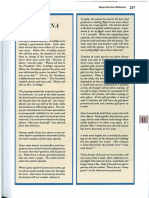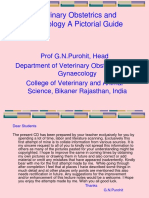Professional Documents
Culture Documents
Embryology: Department of Anatomy & Histology, Khulna Agricultural University
Embryology: Department of Anatomy & Histology, Khulna Agricultural University
Uploaded by
আহানাফ তাহমিদ শব্দOriginal Description:
Original Title
Copyright
Available Formats
Share this document
Did you find this document useful?
Is this content inappropriate?
Report this DocumentCopyright:
Available Formats
Embryology: Department of Anatomy & Histology, Khulna Agricultural University
Embryology: Department of Anatomy & Histology, Khulna Agricultural University
Uploaded by
আহানাফ তাহমিদ শব্দCopyright:
Available Formats
Department of Anatomy & Histology, Khulna Agricultural University
Embryology
Father of Embryology: Aristotle
Embryology = Embryo + logy
Embryo: Developing condition of an animal/ organism
Embryology is the study of embryo and fetus. It is the science that deals with the
origin and development of an individual organism which may be broadly
designated as embryo. It is the study of prenatal development of an individual
organism.
Or
Embryology is the branch of biological science which deals with the study of the
formation of zygote and its gradual development into an independent organism,
either in uterus or in egg shell, upto its individual existence.
Or
Embryology is the study of the growth and development of the embryo and fetus
of an organism from fertilization to extra-uterine life or conception to birth.
Branches / Fields of Embryology:
1. Descriptive embryology: Concern with the direct observation and
description of the structural features of embryos of various ages.
2. Comparative embryology: Concern with comparing among the embryos of
different animals. Comparative embryology throws much light on the
understanding of evolution and phylogenetics significance.
3. Experimental embryology: It is also known as analytical embryology. It
deals with Genetics / Cloning / test tubing. In experimental embryology
experiments are used for understanding the developmental stages. It helps to
understand the fundamental developmental mechanism. Roux is the pioneer
in the field of experimental embryology.
Prepared by Dr. SUBARNA RANI KUNDU Page 1
Department of Anatomy & Histology, Khulna Agricultural University
4. Chemical embryology: Concerned with the studies using biochemical,
biophysical and physiological techniques regarding biochemical component of
embryo. eg. DNA. It is also known as physiological or biochemical
embryology. Needham is the pioneer in the field.
5. Teratology: Concern with the study of malformation.
6. Developmental biology: It includes not only embryonic development but also
postnatal process such as normal and neoplastic growth, metabolism,
regeneration and tissue repair etc.
Objectives/Scope/Importance of Embryology:
1. To know the origin & development of germ cell.
2. To explain the mode of development from a zygote into an independent
individual.
3. To understand the normal & abnormal development of embryo.
4. To determine the sex of a new individual.
5. To understand the evolution.
6. To know the teratological defects.
7. To apply the knowledge of embryology towards pathology, immunology and
other applied subjects.
8. To increase the conception rate of animal.
9. In commercial purpose- cloning of animals and its marketing.
Methods of study:
1. Dissection: Gross dissection of embryo at different age.
2. Microscopic section: At different age of animal embryo.
3. Descriptive study: Materials, study, section and photography.
4. Experimental study: By using various drugs, chemicals, physical or
physiological means.
Prepared by Dr. SUBARNA RANI KUNDU Page 2
Department of Anatomy & Histology, Khulna Agricultural University
Control of the embryonic development
Embryonic development is a process of growth and differentiation in which the
embryo becomes increasingly complex and is more and more enhanced with
structures and functions.
There are a lot of factors responsible for embryonic development. The factors can
be categorized into:
a) Genetic factors, b) Environmental factors, c) Factors of embryonic and
fetal origin, d) Factors of maternal origin
a) Genetic factors:
The "gene architecture" of its chromosomes is responsible for the control of
embryonic development.
b) Environmental factor:
Temperature (hypothermia, hyperthermia )
Anoxia
Adverse climate etc.
c) Factors of embryonic and fetal origin:
Numerous molecules (hormones, growth factors and enzymes) play a role in the
growth and differentiation of the embryo. They are:
• IGF's (insulin-like growth factors)
• Fetal insulin
• Fetal glucocorticoid
• Embryonic cholinesterase (ChE)
• Anti-Müllerian hormone (AMH),
Prepared by Dr. SUBARNA RANI KUNDU Page 3
Department of Anatomy & Histology, Khulna Agricultural University
Further growth factors exist that affect the proliferation, differentiation and
maturation of the cells. They play an important role in embryogenesis. They are:
• EGF (epidermal growth factors)
• TGF (transforming growth factors): TGF-β, activin, BMP [bone
morphogenetic proteins] etc.
• FGF (fibroblast growth factors)
d) Factors of maternal origin:
The following factors of maternal origin affect the embryonic development.
Maternal hormonal status (thyroxin, ACTH, glucocorticoids etc)
Maternal nutrition (glucose, amino acids, vitamins-A, B2, C, D, E, folicacid,
pantothenic and, niacin, minerals- iodine, manganese etc)
Mother suffering with disease such as Blue tongue in sheep, Hog cholera in
swine, Feline panleucopenia in cat, Bovine viral diarrhea in cattle etc.
Radiation
Periods:
Embryonic Period — defined as the time from fertilization to the earliest
(primordial) stages of organ development (about 30 days in dog, cat, sheep, pig;
almost 60 days in horse, cattle, human).
Fetal Period — It is the time between the embryonic period and parturition (the
end of gestation), during which organs grow and begin to function.
Prepared by Dr. SUBARNA RANI KUNDU Page 4
Department of Anatomy & Histology, Khulna Agricultural University
EMBRYOGENESIS
Embryogenesis is the process by which the embryo is formed and develops, until
it develops into a fetus. Embryogenesis includes the following phases:
1. Gametogenesis
2. Fertilization
3. Cleavage & Blastulation
4. Gastrulation
5. Organogenesis
6. Growth &
7. Differentiation
GAMETOGENESIS
Male or female reproductive germ cells are known as gamete. Gametogenesis is
the process of production of gamete in the gonads (i.e. testis in male and ovary in
female). Gametogenesis is two types: Spermatogenesis & Oogenesis.
Spermatogenesis
Spermatogenesis is the process by which spermatozoa is produced. This process takes
place in the seminiferous tubules of testis of male animals and the spermatozoa is
developed from the spermatogonium. In other word, the sequence of events of
formation of spermatozoa is referred to as spermatogenesis.
The following developmental stages are found in the course of spermatogenesis:
A-spermatogonium
B-spermatogonium
Primary spermatocyte
Secondary spermatocyte
Spermatid
Sperm cell (spermatozoon)
Prepared by Dr. SUBARNA RANI KUNDU Page 5
Department of Anatomy & Histology, Khulna Agricultural University
The spermatogenesis can be subdivided into three successive sections:
a) Spermatocytogenesis,
b) Meiosis &
c) Spermiogenesis.
Sometimes, the step ‘Spermination’ is also included in the process ‘Spermatogenesis’.
Duration of spermatogenesis is different in different animals (Human - 74 days, Bull -
61 days, Stallion – 55 days, Buck - 49 days, Ram - 42 days). The approximate 64
day cycle of the spermatogenesis can be subdivided into four phases that last for
different lengths of time:
Mitosis of the
16 days Up to the primary spermatocytes
spermatogonia
First meiosis 24 days For the division of the primary spermatocytes
to form secondary spermatocytes
Second meiosis A few hours For engendering the spermatids
Spermiogenesis 24 days Up to the completed sperm cells
Total - 64 days
Spermatocytogenesis
Spermatocytogenesis is the process by which spermatogonium transform into primary
spermatocyte.
During spermatocytogenesis, spermatogonia multiply sequentially & by mitotically,
resulting in type A spermatogonia (type A), then intermediate spermatogonia (type I),
type B spermatogonia (type B) and finally primary spermatocytes.
Prepared by Dr. SUBARNA RANI KUNDU Page 6
Department of Anatomy & Histology, Khulna Agricultural University
Type A spermatogonia are the largest spermatogonia and share an extensive contact
area with the tubular basal lamina. They possess prominent nuclei with prominent
nucleoli and a pale or cloudy appearance. Intermediate spermatogonia are in between
type A & B spermatogonia. Type B spermatogonia have spherical nuclei containing
numerous chromatin particles and less prominent nucleoli. The mitotic division of
Type B spermatogonia results in the formation of primary spermatocytes.
Meiosis
Meiosis is the maturation division of spermatocytes that results in spermatids with a
reduced (haploid) number of chromosomes.
During meiosis, two successive nuclear divisions occur (1 st & 2nd maturation division),
resulting the formation of four haploid spermatids from one primary spermatocyte.
The first maturation division proceed following the phases: the prophase (subdivided
into leptotene, zygotene, pachytene, diplotene & diakinesis), metaphase, anaphase
& telophase and resulting the formation of two secondary spermatocytes from one
primary spermatocyte. Each secondary spermatocyte possesses only half the number
(haploid) of chromosomes but have two chromatids each. Secondary spermatocytes are
short-lived, intermediate in size between primary spermatocytes and spermatids.
After a short period of interphase, during which no duplication of genetic material
occurs, the secondary spermatocytes undergo the second maturation division with a
short prophase followed by metaphase, anaphase & telophase, which are essentially
similar to those of mitotic divisions and resulting the formation of two spermatids from
a single secondary spermatocyte and these cells possess a haploid set of chromosome.
The spermatids are the smallest cells of the germinal epithelium.
Since in the secondary spermatocytes neither DNA reduplication nor a recombination
of the genetic material occurs, the second meiosis can take place quickly. It lasts only
around five hours and for that reason secondary spermatocytes are rather seldom seen
in a histological section.
Prepared by Dr. SUBARNA RANI KUNDU Page 7
Department of Anatomy & Histology, Khulna Agricultural University
Spermiogenesis (Spermatohistogenesis)
The differentiation / transformation of the spermatids into sperm cells / spermatozoa is
called spermiogenesis. Spermatids are transformed into sperm cells with the active
assistance of the Sertoli cells. It is the final part of spermatogenesis. The most
important morphologic changes occur during spermiogenesis are:
Nuclear condensation: Thickening and reduction of the nuclear size,
condensation of the nuclear chromatin.
Acrosome formation: Forming a cap (acrosome) containing enzymes that play
an important role in the penetration through the pellucid zone of the oocyte.
Formation of a motile tail or flagellum
Loss of excess spermatid materials (cytoplasm, water, organelles) those are
not necessary for the later spermatozoon.
Spermiogenesis is divided into Golgi phase, cap phase, acrosomal phase, and
maturation phase. In routine histologic sections, the Golgi & cap phases are
characterized by spherical nucleus and the acrosomal & maturation phases are
characterized by elongated nucleus.
Golgi phase: During the Golgi phase, proacrosomal granules appear in the Golgi
vesicles.
Cap phase: During the cap phase, the acrosomal vesicle grows and forms the head cap
that covers the anterior two-thirds of the nucleus.
Acrosomal phase: During this phase,
- The nucleus & cell body start to elongate in a cranio-caudal direction.
- Formation of acrosomal cap.
Maturation phase: During this phase,
- Nuclear condensation is completed.
- Excess cytoplasm is detached as residual body.
Prepared by Dr. SUBARNA RANI KUNDU Page 8
Department of Anatomy & Histology, Khulna Agricultural University
Spermination
Spermination is the release of the spermatozoa from and/ between the Sertoli cells into
the lumen of the seminiferous tubules.
Cell Line of Spermatogenesis
Primordial Germ cell
Migrate and proliferate to form undifferentiated gonads
Primordial cells divide to form gonocytes
Before puberty, gonocytes differentiate into type A spermatogonia
(Type Ao →A1 →A2 →A3 →A4)
Prepared by Dr. SUBARNA RANI KUNDU Page 9
Department of Anatomy & Histology, Khulna Agricultural University
Intermediate spermatogonia
Type B spermatogonia
Primary spermatocytes
Secondary spermatocytes
Spermatids
Spermatozoa
Prepared by Dr. SUBARNA RANI KUNDU Page 10
Department of Anatomy & Histology, Khulna Agricultural University
Spermatozoa
A spermatozoa is a slender, motile flagellate body, the male germ cell. It has been
estimated that about 60,000 spermatozoa contained within 1mm3 seminal fluid or
200-600 million in a single ejaculation. The concentration of spermatozoa varies
greatly among different species. Spermatozoa vary in length between
approximately 60 μm (boars, stallions) to 75 μm (ruminants). With the light
microscope, the spermatozoon seems to consist essentially of two portions: the
head & the tail (flagellum, use to swim through liquids). With the electron
microscope, the tail is seen to be subdivided further into neck, middle piece,
principle piece, and end piece.
Head: The shape of the nucleus determines the shape of the head of the
spermatozoon, which is species-dependent and subject to great variations. The
anterior pole of the nucleus is covered by the acrosomal cap, with an outer & inner
acrosomal membrane that fuse at the caudal end. The acrosomal cap contains
several hydrolytic & proteiolytic enzymes (eg. acrosin), which are become free
during the acrosomal reaction of capacitated spermatozoa in the uterine tube.
Acrosomal enzymes are needed for the penetration of the zona pellucida during
fertilization. The caudal end of the acrosome is characterized by a narrowing of the
cap and condensation of its contents. The base of the nucleus is surrounded by the
postacrosomal sheath, which consists of fibrous proteins rich in sulfur. The plasma
membrane of the post postacrosomal head region contains receptor molecules
necessary for the recognition of homologous oocyte. At the caudal surface of the
sperm head, the nuclear envelop lines an implantation groove where the tail is
inserted in a joint manner.
Neck: The neck is a relatively short & narrow structure between the head &
middle piece (connecting piece). It consists of a centrally located centriole and nine
peripheral longitudinally oriented coarse fibers continuous with the outer fibers of
the middle piece.
Middle piece: The core of the middle piece has the characteristic structure of a
flagellum: two central microtubules & nine peripheral doublets (microtubules)
making up the axial filament complex. They are surrounded by nine longitudinally
Prepared by Dr. SUBARNA RANI KUNDU Page 11
Department of Anatomy & Histology, Khulna Agricultural University
oriented outer fibers that are connected to the fibers of the connecting piece. These,
in turn, are surrounded by the mitochondria (essential for the sperm to successfully
survive on its journey to the female egg) in a helical arrangement. A ring-shaped
thickening of the plasma membrane (annulus) of the middle piece marks the limit
between the middle piece and the principle piece.
Principle piece: The principle piece is the longest portion of the spermatozoon.
The axial filament complex has a structure identical to that of the middle piece and
is surrounded by the continuing outer fibers of the middle piece. The fibers are
subject to variation in size & shape and gradually taper toward the end of the
principle piece.
End piece: The termination of the fibrous sheath marks the beginning of the end
piece, which contains only the axial filament complex. Proximally, in the end
piece, this complex has its characteristic nine peripheral doublets; distally, these
doublets gradually become reduced to singlets and terminate at various levels.
A sperm cell contains certain elements that allow it to remain "alive" for a short
period of time. These elements are various, but the most important are a plasma
membrane (effectively sealing the cell, allowing only certain things to come
through) and mitochondria (energy-producing organelles).It can only survive in the
male reproductive tract, in the female reproductive tract (only when certain
conditions are present) and in certain artificial environments.
Prepared by Dr. SUBARNA RANI KUNDU Page 12
Department of Anatomy & Histology, Khulna Agricultural University
Fig. The spermatozoa; 1. Plasma membrane; 2. Outer acrosomal membrane; 3.
Acrosome; 4. Inner acrosomal membrane; 5. Nucleus; 6. Proximal centriole; 7.
Rest of the distal centriole; 8. Thick outer longitudinal fibers; 9. Mitochondrion;
10. Axoneme; 11. Anulus; 12. Ring fibers; A. Head; B. Neck; C. Mid piece; D.
Principal piece; E. End piece
Acrosome: The acrosome is a membrane covering the anterior 2/3 of the sperm
nucleus. It contains several hydrolytic & proteolytic enzymes, which are become
free during the acrosomal reaction of capacitated spermatozoa in the uterine tube.
Acrosomal enzymes are needed for the penetration of the zona pellucida during
fertilization. The enzymes include neuroaminidase, hyaluronidase, aryl
phosphatase, aryl sulfatase, acrosin.
Acrosomal reaction: Binding of a spermatozoon to a secondary oocyte triggers
release of these enzymes, which digest the extracellular matrix of the oocyte,
thereby facilitating access of the spermatozoon to the plasma membrane of the
oocyte. This process is known as the acrosomal reaction.
Prepared by Dr. SUBARNA RANI KUNDU Page 13
Department of Anatomy & Histology, Khulna Agricultural University
Oogenesis:
Oogenesis is the process by which the female gamete or ovum or the female sex cell or
the female germ cell is produced. It is the female form of gametogenesis. Oogenesis
consists of several sub-processes: oocytogenesis, ootidogenesis, and finally maturation
to form an ovum (oogenesis proper).
Primordial Germ cell multiply mitotically resulting increased in number and become
ooginia and some of these oogonia go in the process of oogenesis.
Oogonium --(Oocytogenesis)--> Primary Oocyte --(Meiosis I)-->First Polar Body
(Discarded afterward) + Secondary oocyte --(Meiosis II)--> Secondary Polar Body
(Discarded afterward) + Ovum.
Oocytogenesis
Oogenesis starts with the process of developing oogonia, which occurs via the
transformation of primordial follicles into primary oocytes, a process called
oocytogenesis. Oocytogenesis is completed either before or shortly after birth.
Ootidogenesis
The succeeding phase of ootidogenesis by which the primary oocyte develops into
an ootid by the process of meiosis.
However, although this process begins at prenatal age, it stops at prophase I. In late
fetal life, all oocytes, still primary oocytes, have halted at this stage of
development, called the dictyate. After menarche, these cells then continue to
develop, although only a few do so in every estrus / menstrual cycle.
Meiosis I
Meiosis I of ootidogenesis begins during embryonic development, but halts in the
diplotene stage of prophase I until puberty. (For those primary oocytes that
continue to develop in each estrus / menstrual cycle, however, synapsis occurs and
tetrads form, enabling Chromosomal crossover to occur.) As a result of meiosis I,
the primary oocyte has developed into the secondary oocyte and the first polar
body.
Prepared by Dr. SUBARNA RANI KUNDU Page 14
Department of Anatomy & Histology, Khulna Agricultural University
Meiosis II
Immediately after meiosis I, the haploid secondary oocyte initiates meiosis II.
However, this process is also halted at the metaphase II stage until fertilization, if
such should ever occur. When meiosis II has completed, an ootid and another polar
body have now been created.
Maturation into ovum
Both polar bodies disintegrate at the end of Meiosis II, leaving only the ootid,
which then eventually undergoes maturation into a mature ovum.
The function of forming polar bodies is to discard the extra haploid sets of
chromosomes that have resulted as a consequence of meiosis.
Fig: Oogenesis
Prepared by Dr. SUBARNA RANI KUNDU Page 15
Department of Anatomy & Histology, Khulna Agricultural University
Comparison between Spermatogenesis and Oogenesis:
Spermatogenesis Oogenesis
1) Process of formation of mature sperm. 1) Process of formation of mature ovum.
2) It begins at puberty. 2) It begins before birth.
3) Spermatogenesis takes place in testes. 3) Oogenesis takes place in ovaries.
4) As a result, spermatozoa are formed, 4) Egg is typically large, non-motile and
which are typically much smaller and contains yolk, which supplies
motile adapted to swim actively to the nourishment to the developing embryo.
egg by lashing movements of the tail.
5) Primordial germ cell is 5) Primordial germ cell is oogonium.
spermatogonium.
Prepared by Dr. SUBARNA RANI KUNDU Page 16
Department of Anatomy & Histology, Khulna Agricultural University
6) Four spermatozoa are produced from 6) Only a single ovum is produced from
each primary sprematocyte. each primary oocyte.
7) Polocytes / polar bodies are not formed. 7) Polocytes are formed so that mature egg
may have haploid number of
chromosomes.
8) Billions of spermatozoa produce at a 8) One ovum (oocyte) matures monthly.
time.
9) Process ends at death. 9) Process ends at Menopause or after a
definite period of time.
Prepared by Dr. SUBARNA RANI KUNDU Page 17
Department of Anatomy & Histology, Khulna Agricultural University
Hormonal Control of Oogenesis:
Early hormone control helps the follicle to develop and forces oogenesis to occur in a
cycle in a certain time period. The control begins in the hypothalamus which produces
gonadotropin-releasing hormone (GnRH). GnRH is received by receptors in the
anterior pituitary gland, which responds by releasing Follicle Stimulating Hormone
(FSH) and Luteinizing Hormone (LH). At the beginning of development, the granulosa
cells express FSH receptors, which stimulate growth of the follicle. Theca cells express
receptors for LH, which stimulates growth of the corpus luteum. Theca cells also
produce androgens, which the granulosa cells convert to estrogen. Estrogen act back
on the anterior pituitary gland to further FSH and LH surges, and also supports the
growth of the endometrium. At some point, the dominate follicle begins to secrete
inhibin, which acts back on the anterior pituitary gland to stop producing FSH. Only
the dominant follicle, which is now FSH independent, will continue to grow.
During further development, the granulosa cells increase their FSH receptors and
express LH receptors, while the Theca cells increase their LH receptors. This surge in
hormone reception results in ovulation. After ovulation, if fertilization occurs, the
corpus luteum secretes progesterone that supports the further growth of the
endometrium. If, however, fertilization does not take place, then the hormone levels
drop, the corpus luteum breaks down, no longer secreting progesterone, so that the
endometrium sloughs off producing menstruation.
Prepared by Dr. SUBARNA RANI KUNDU Page 18
Department of Anatomy & Histology, Khulna Agricultural University
Structure of Secondary Oocyte/ Mature Ovum:
1. It is larger than other cells. Diameter is about 150 μ.
2. The cell membrane is known as vitelline membrane. It is surrounded by zona
pellucida.
3. The space between vitelline membrane and zona pellucida is known as
perivitelline space.
4. The nucleus is large, eccentric and contains half number of chromosomes.
5. The ooplasm or yolk is similar to that of other cells in most of the mammals.
This type of egg is known as microlecithal eggs. The eggs of birds contain
abundant nutritive yolk (deutoplasm) and therefore called macrolecithal eggs.
6. The cells surrounding the oocyte are attached to the zona pellucida in a radiating
manner. This cellular arrangement is called corona radiate.
Prepared by Dr. SUBARNA RANI KUNDU Page 19
Department of Anatomy & Histology, Khulna Agricultural University
FERTILIZATION
Fertilization (also known as 'conception', 'fecundation' and 'syngamy'), is the fusion of
gametes to produce a new organism. In animals, the process involves a sperm fusing
with an ovum, which eventually leads to the development of an embryo. The fertilized
egg cell is known as the zygote.
fertilization begins with gamete fusion (zygote formation)
fertilization ends with the initiation of zygote cell division (the start of cleavage)
Depending on the animal species, there are two types of fertilization: External
Fertilization & Internal Fertilization
External Fertilization
External fertilization occurs mostly in wet environments and requires both the male
and the female to release their gametes into their surroundings (usually water). An
advantage of external fertilization is that it results in the production of a large number
of offspring. One disadvantage is that environmental hazards such as predators greatly
reduce the chance of surviving into adulthood. Amphibians and fish are examples of
animals that reproduce this way.
Internal Fertilization
Internal fertilization occurs within the body of the female animals. Animals that use
internal fertilization specialize in the protection of the developing egg. For example,
reptiles and birds secrete eggs that are covered by a protective shell that is resistant to
water loss and damage. Mammals take this idea of protection a step further by
allowing the embryo to develop within the mother. This extra protection increases the
chances of survival because mom supplies everything that the embryo needs. In fact,
most mammalian mothers continue to care for their young for several years after birth.
Site of fertilization: Fertilization occurs in the ampulla of the uterine tube.
Prepared by Dr. SUBARNA RANI KUNDU Page 20
Department of Anatomy & Histology, Khulna Agricultural University
Fertilization is a chain of events. Interruption of any step in the chain will almost
certainly cause fertilization failure. The chain begins with a group of changes affecting
the sperm, which prepares them for the task ahead.
Process of fertilization:
In overview, fertilization can be described as the following steps:
a) Transport of spermatozoa
About 200-300 million of spermatozoa deposit along with male accessory sex
glandular fluid in the female reproductive tract. Among them 300-500 reach the site of
fertilization, but only one is reached for fertilization and others help in barrier
penetration. By this time, sperm become capacitated and only the capacitated sperm
pass through the corona radiata and undergoes the acrosome reaction.
Sperm Capacitation
Freshly ejaculated sperm are unable or poorly able to fertilize. Rather, they must first
undergo a series of changes known collectively as capacitation. Capacitation is the
process by which sperm becomes capable of fertilizing ovum after it reaches the
ampulla of the uterine tube. Capacitation is associated with removal of adherent
seminal plasma proteins, reorganization of plasma membrane lipids and proteins. It
also seems to involve an influx of extracellular calcium, increase in cyclic AMP, and
decrease in intracellular pH. Sperm that have undergone capacitation are said to
become hyperactivated, and display hyperactivated motility. Only the capacitated
sperm pass through the corona radiate and undergoes the acrosome reaction.
b) Barrier penetration
Penetration of corona radiata & Sperm-Zona Pellucida binding
The corona radiate cells are dispersed by the hyaluronidase enzyme. Acrosomal cap of
spermatozoa releases this enzyme and facilitates the sperm to bind with zona pellucida.
Binding of sperm to the zona pellucida is a receptor-ligand interaction with a high
degree of species specificity. The carbohydrate groups on the zona pellucida
glycoproteins function as sperm receptors.
Prepared by Dr. SUBARNA RANI KUNDU Page 21
Department of Anatomy & Histology, Khulna Agricultural University
Penetration of the Zona Pellucida
The constant propulsive force from the sperm's flagellating tail, in combination with
acrosomal enzymes, allow the sperm to create a tract through the zona pellucida. These
two factors - motility and zona-digesting enzymes (acrosin / zona lysin – a trypsin like
substance)- allow the sperm to traverse or lysis the zona pellucida. The enzyme ‘zona
lysin’ is released during the acrosome reaction. (The acrosome - a huge modified
lysosome that is packed with zona-digesting enzymes and located around the anterior
part of the sperm's head.) As one spermatozoon enters the cytoplasm of the oocyte,
thickening and hardening of the zona pellucida repair the entry point of the oolema
(plasma membrane of the oocyte) and inhibit the further entrance of any sperm. This
inhibition of further entrance of any sperm is called vitelline block.
c) Sperm-Oocyte Binding
Once a sperm penetrates the zona pellucida, it binds to and fuses with the plasma
membrane of the oocyte (oolema). Binding occurs at the posterior (post-acrosomal)
region of the sperm head. A sperm glycoprotein called fertilin, which binds to a
protein in the oocyte plasma membrane and may also induce fusion.
d) Egg Activation and the Cortical Reaction
Prior to fertilization, the egg is in a quiescent state, arrested in metaphase of the second
meiotic division. Upon binding of a sperm, the egg rapidly undergoes a number of
metabolic and physical changes that collectively are called egg activation. Prominent
effects include a rise in the intracellular concentration of calcium, completion of the
second meiotic division and the so-called cortical reaction.
Cortical Reaction:
The cortical reaction refers to a massive exocytosis of cortical granules seen shortly
after sperm-oocyte fusion. Cortical granules contain a mixture of enzymes, including
several proteases, which diffuse into the zona pellucida following exocytosis from the
egg. These proteases alter the structure of the zona pellucida, inducing what is known
as the zona reaction.
Prepared by Dr. SUBARNA RANI KUNDU Page 22
Department of Anatomy & Histology, Khulna Agricultural University
Zona Reaction:
The zona reaction refers to an alteration in the structure of the zona pellucida catalyzed
by proteases from cortical granules. The critical importance of the zona reaction is that
it represents the major block to polyspermy in most mammals. This effect is the result
of two measurable changes induced in the zona pellucida:
1. The zona pellucida hardens. Runner-up sperm that have not finished traversing
the zona pellucida by the time the hardening occurs are stopped in their tracks.
2. Sperm receptors in the zona pellucida are destroyed. Therefore, any sperm that
have not yet bound to the zona pellucida will no longer be able to bind and
fertilize the egg.)
e) Post-fertilization events (formation of male & female pronuclei and their
fusion)
During cortical reaction, the second meiotic division of oogenesis is completed
resulting the formation the ovum and the second polar body. Than the ovum form the
female pronucleus and the polar body disappears. Following fusion of the fertilizing
sperm with the oocyte, the sperm head is incorporated into the egg cytoplasm. The
nuclear envelope of the sperm disperses, and the chromatin rapidly loosens from its
tightly packed state in a process called decondensation. Chromatin from both the
sperm and egg / ovum are soon encapsulated in a nuclear membrane, forming
pronuclei. Each pronucleus contains a haploid genome.
Prepared by Dr. SUBARNA RANI KUNDU Page 23
Department of Anatomy & Histology, Khulna Agricultural University
The male and female pronuclei fuse together, their membranes break down, and the
two genomes condense into chromosomes, thereby reconstituting a diploid organism
(zygote).
Zygote: The body or structure formed by the union of the male and female pronuclei
due to fertilization and having the capability of mitosis is known as zygote
Results of fertilization:
Formation of zygote.
Restoration of diploid number of chromosome.
Determination of sex in the new individual.
The cleavage process is started.
CLEAVAGE & BLASTULATION
Cleavage is the series of mitotic cell division of the zygote which takes place
immediately after fertilization. Each & every cell derived from cleavage, up to the
blastula stage, is called blastomere. The increment of blastomere tends typically to
following the doubling sequence such as 2, 4, 8, 16, 32 and so on. The sixteen cells
stage of blastomeres is known as the morula due to its general resemblance to a
mulberry (a dense ball). During morula stage, the polar body will be disappeared. The
first cleavage division occurs 1 to 5 days following ovulation (depending on species),
thereafter cells divide about once every 12 hours.
Prepared by Dr. SUBARNA RANI KUNDU Page 24
Department of Anatomy & Histology, Khulna Agricultural University
Fig: Cell divisions during cleavage; d – Morula
As cleavage proceeds, the number of morular blastomeres increase and blastomeres
undergo a profound rearrangement. At first the cells of the morula are closely
aggregated, but soon they become arranged into an outer or peripheral layer, a true
epithelium (single layered), the trophoblast, which does not contribute to the formation
of the embryo proper, and an inner cell mass (a small cluster of cells), from which the
embryo is developed. Between the trophoblast and the inner cell-mass, a cavity is
formed known as blastocoel which contains uterine fluid. (Some uterine fluid enters
into the morula & by the action of this fluid, the cells go to the periphery & formed a
central cavity, blastocoel). The inner cell mass remains in contact with the trophoblast
at one pole of the ovum; this is named the embryonic pole, since it indicates the
location where the future embryo will be developed. This embryonic stage is called
blastula and the process of its formation is called blastulation. Blastula contains more
than 100 cells. The blastula is usually a spherical layer of cells. Blastula is known as
different names in different species – in mammals as the blastocyst, in amphibians as
the blastoderm and in birds & reptiles as the blastodisc.
Prepared by Dr. SUBARNA RANI KUNDU Page 25
Department of Anatomy & Histology, Khulna Agricultural University
Before gastrulation, the zona pellucida fully disappears and the inner cell mass become
very prominent and the trophoblast cells become flattened. When the zona pellucida is
disappeared, the blastula attaches with the endometrium which is termed as
implantation.
The trophoblast cells become differentiated into two strata: the outer stratum termed
the syncytiotrophoblast; while the inner layer, the cytotrophoblast or “Layer of
Langhans”. The cytotrophoblast cells are mitotically active but the syncytiotrophoblast
cells are not. The syncytiotrophoblasts invade the endometrium with three
characteristics: 1) they have invasive power, 2) they have ingestive character & 3) they
have digestive character. By invading, they get nutrition from the exposed glands &
blood vessels of the endometrium. Subsequently, the trophoblasts form placenta &
extra-embryonic (fetal) membranes and the inner cell mass give rise to future embryo.
Cleavage:
It refers to the initial series of mitotic divisions by which the large zygote is
fractionated into numerous “normal size” cells. each daughter cell of the cleavage
process is termed a blastomere. cleavage begins with a zygote, progresses through
compaction to a morula stage and terminates at the start of the blastocyst (blastula)
stage the first eight blastomeres are undifferentiated and have identical potential in
mammals; thereafter, blastomeres differentiate into inner & outer cells with
different missions
Morula
It is a solid ball of blastomeres within a zona pellucida (typically consisting of 16
to 64 blastomeres) blastomeres become compacted; cells on the inside differentiate
from those along the surface of the morula:
outer blastomeres become flattened and form tight junctions (reducing fluid
permeability); they develop the capacity to secrete fluid (internally); they are
destined to become trophoblasts which form the chorion & amnion (fetal
membranes) of the conceptus;
inner blastomeres form gap junctions to maximize intercellular communication;
they are destined to become inner cell mass which forms the embryo itself (plus
two fetal membranes).
Prepared by Dr. SUBARNA RANI KUNDU Page 26
Department of Anatomy & Histology, Khulna Agricultural University
Note: As few as three inner blastomeres are sufficient to produce an entire embryo
(and adult). When a morula leaves the uterine tube and enters the uterus (uterine
horn) it is at about the 16-cell stage, around 4 to 7 days after fertilization
(depending on species). The 32-cell stage morula (5-7 days post ovulation) is ideal
for embryo transfer in cattle.
Blastocyst (or Blastula)
develops during the second week, after the zona pellucida ruptures consists of a
large number of blastomeres arranged to form a hollow, fluid-filled, spherical or
cylindrical structure contains an inner cell mass (embryoblast), evident as a
collection of cells localized inside one polar end of the blastula surface cells of the
blastocyst are designated trophoblasts (future chorion of the conceptus) the cavity
of the blastocyst is called a blastocoele eventually the blastocyst attaches to or
implants within the uterine wall (pending species).
Implantation
The blastocyst is initially free in the uterine lumen (nourished by uterine glands).
Implantation of the blastocyst is a gradual process, beginning with apposition,
leading to adhesion (or invasion in the case of the human & Guinea Pig).
Approximate implantation times are: one week (human); two weeks (dog, cat,
sheep), 3-5 weeks (cattle), 3-8 weeks horse; or delayed up to 4 months (deer,
bears).
Prepared by Dr. SUBARNA RANI KUNDU Page 27
Department of Anatomy & Histology, Khulna Agricultural University
TWINS
Monozygotic:
Identical (same genetic composition) twins can result from either:
1. separation of early blastomeres (up to the 8-cell stage)—each of the separate
blastomere(s) develops into an independent conceptus; or
2. separation of inner blastomeres within a single morula—each of the separate
blastomere(s) develops into an independent embryo and both embryos share a
common placenta (this is less common than the first possibility).
Note: Separations later in embryonic development result in conjoined twins
(diplopagus; Siamese twins), or double heads, etc. types of anomalies.
Dizygotic: fraternal twins result when two zygotes develop “independently” during
the same pregnancy (independence can be compromised by fusion of fetal
membranes and blood supplies). It is possible for fraternal blastomeres to merge
and produce a single conceptus with two different genotypes (a chimera).
GASTRULATION (Formation of the germ layers)
The events which transform blastula into a gastrula are collectively called gastrulation.
According to Lankester (1875) and Hubrecht (1906), the gastrulation is a process
during which the single layered blastula is converted into a two layered (eg.-
Amphioxus) or three layered (eg.- most vertebrates) embryonic stage called gastrula.
Formation of the germ layers
During development, morphogenetic processes (e.g., cavitation, invagination,
migration, and proliferation) rearrange the cells. Three principal laminae, known as the
primary germ layers, develop from the inner cell mass by about two weeks after
fertilization. The outermost, middle, and innermost layers are the ectoderm,
mesoderm, and endoderm, respectively. Further differentiation of the primary germ
layers will produce the major tissue types. All three germ layers participate in
formation of the functional organs and organ systems. Each germ layer normally
contributes to specific features, but it can form additional structures under certain
natural or experimental influences (e.g., transplantation). Thus, the germ layers are no
longer considered rigidly specific.
Prepared by Dr. SUBARNA RANI KUNDU Page 28
Department of Anatomy & Histology, Khulna Agricultural University
Gastrulation includes the following sequence, beginning with a blastocyst:
A thickened embryonic disc becomes evident at the blastocyst surface, due to
cell proliferation of the inner cell mass cells. Trophoblast cells overlaying the
inner cell mass degenerate in domestic mammals (in the mouse and human,
trophoblast cells become amnionic wall).
From the inner cell mass, cells proliferate, break loose (delaminate), and
migrate to form a new cell layer inside the trophoblast layer, the hypoblast, will
form a yolk sac. The remaining inner cell mass may be called the epiblast.
On the epiblast surface, a primitive streak forms as differential cell growth
generates a pair of ridges separated by a depression. [NOTE: The primitive
streak defines the longitudinal axis of the embryo and indicates the start of germ
layer formation.]
Hypoblast Formation (three stage)
Prepared by Dr. SUBARNA RANI KUNDU Page 29
Department of Anatomy & Histology, Khulna Agricultural University
Deep to the primitive streak, a space (coelom/celom) becomes evident between
the hypoblast layer and epiblast. Subsequently, the coelom is filled by
mesoderm that undergoes cavitation and gives rise to body cavities.
Epiblast cells proliferate along primitive streak margins and migrate through the
streak into the coelom. The migrating cells form endoderm & mesoderm layers.
Initial migrating cells join the hypoblast layer, forming embryonic endoderm
(hypoblast cells constitutes yolk sac endoderm).
The majority of migrating cells enter the coelom as primary mesenchyme and
become mesoderm. The primary mesenchyme migrates laterally and cranially
(but not along the midline region directly cranial to the primitive streak where
notochord will form). Note: Mesoderm divides into: paraxial, intermediate, and
lateral mesodermal regions.
Within the lateral mesoderm, cavitation re-establishes a coelom. The mesoderm
splits into two layers bordering the coelom—somatic mesoderm is attached to
the ectoderm and splanchnic mesoderm is joined to endoderm.
The remaining epiblast becomes ectoderm which forms skin epidermis &
nervous system.
Prepared by Dr. SUBARNA RANI KUNDU Page 30
Department of Anatomy & Histology, Khulna Agricultural University
Derivatives of germ layers and development of the organ systems:
Ectoderm produces: 1) Outer epithelium of the body: the epidermis and epidermal
derivatives of the integumentary system, including the hair follicles, nails, and the
glands that communicate with the skin surface (i.e., the sudoriferous, mammary, and
sebaceous glands). The lining of the mouth, salivary glands, nasal passageways, and
anus develop from ectoderm, as does portions of the skull, pharyngeal arches, teeth,
and endocrine system (pituitary and parts of adrenal glands); 2) Neural tube: brain,
spinal cord, neurohypophysis, optic nerve, retina, motor spinal nerve root; 3) Neural
crest: spinal dorsal root ganglia, cranial sensory ganglia etc.
Mesoderm produces the lining of the pleural, pericardial, and peritoneal cavities, the
muscular, skeletal, cardiovascular, and lymphatic systems, the kidneys and portions of
the urinary tract, the gonads and most of the reproductive tracts, and the connective
tissues that support all organ systems. Portions of the endocrine system (parts of the
adrenal glands and endocrine tissues of the reproductive system) also develop from
mesoderm.
Prepared by Dr. SUBARNA RANI KUNDU Page 31
Department of Anatomy & Histology, Khulna Agricultural University
[ Mesoderm → Head mesenchyme, dorsal mesoderm (somite), intermediate mesoderm
& lateral mesoderm.
Head mesenchyme → Cephalic connective tissue & muscle, dentine, outer layer of
eye, skull.
Dorsal mesoderm (somite) → Sclerotome (axial & appendicular skeleton), myotome
(limb & trunk muscle) & dermatome (connective tissue layer of skin).
Intermediate mesoderm → Pronephros, mesonephros, metanephros, metanephric
diverticulum of uterus, renal pelvis, collecting duct; mesonephric duct (male genital
duct system) & mullerian duct (oviduct, uterus, vagina).
Lateral mesoderm → Splanchnic mesoderm (visceral pleura, pericardium, peritoneum;
mesenteries, heart, blood vessels & capillaries) and somatic mesoderm (pleura,
pericardium, peritoneum). ]
Endoderm produces most of the epithelium of the digestive system (except the mouth
and anus), the exocrine glands (except salivary glands), and the liver and pancreas.
Most of the respiratory system, including the epithelium (except that of the nasal
passageways) and mucous glands develop from endoderm, as does portions of the
urinary and reproductive systems (the stem cells that produce gametes). Pharyngeal
pouches (first pouch – middle ear, auditory tube, endodermal lining of tympanic
membrane ; second pouch – tonsillar recess; third pouch – thymus, thyroid; fourth
pouch – parathyroid, post bronchial body) also develop from endoderm.
Prepared by Dr. SUBARNA RANI KUNDU Page 32
Department of Anatomy & Histology, Khulna Agricultural University
ORGANOGENESIS (formation of body structures & organs)
Organogenesis is the process by which the ectoderm, endoderm, and mesoderm
develop into the internal organs of the organism. The germ layers in organogenesis
differ by three processes: folds, splits, and condensation. The continuous masses of the
cells of the three germinal layers split up into smaller groups of cells, called the
primary organ rudiments, each of which is destined to produce a certain organ or part
of the adult animal body. The primary organ rudiments further subdivided into
secondary organ rudiments which are rudiments of the subordinate and simpler organs
and parts. With the appearance of primary and secondary organ rudiments, the embryo
begins to show some similarity to the adult animal.
GROWTH
Growth may be defined as the developmental increase in mass. After the organ
rudiments are formed they begin to grow and greatly increase their volume. Growth
results from synthesis of new protoplasm, both the cytoplasmic and nucleic. Increase
in mass is usually accompanied by cell division and also by increasing of intercellular
substances. In this way, the animal gradually achieves the size of its parents.
DIFFERENTIATION
Cellular differentiation (specialization) is the process by which a less specialized cell
becomes a more specialized cell type. In this process groups of cells acquire special
characteristics and undertake specific function. Tissues and organs are laid down in the
developing embryo in a methodical and sequential manner.
Differentiation refers to the events by which cells and other parts become different
from one another. Differentiation dramatically changes a cell's size, shape, membrane
potential, metabolic activity, and responsiveness to signals. After growth the cells in
each rudiment become differentiated, i.e., they acquire a diversification of form and
function.
Differentiation is of three types:
Prepared by Dr. SUBARNA RANI KUNDU Page 33
Department of Anatomy & Histology, Khulna Agricultural University
1) Morphological differentiation
Individual cells and their groups become structurally different from other cells and
groups of cells. For example, from a common starting point in generalized ectoderm,
epidermal and nerve cells acquire the distinguishing characteristics of size, shape and
internal structure.
2) Behavioral differentiation
Although the cells exhibit common basic properties like metabolism, irritability, some
cells possess some special capabilities along the general properties. For example, nerve
cells take up the responsibility to transport electrical impulses, muscles to contract,
gland cells to secrete special secretions and so on.
3) Chemical differentiation
The individual cells become biochemically different from one another as the egg
undergoes cleavage and progressively becomes converted to blastula, gastrula and
definitive embryo.
Fetal membrane
The fetal membrane surrounds the fetus during pregnancy. Four fetal membranes
develop in a conceptus. Two arise from the trophoblast layer of the blastocyst and
are continuous with the somatopleure of the embryo. Two arise from the inner cell
mass of the blastocyst and are continuous with splanchnopleure of the embryo;
these two splanchnopleure membranes are vascular. The four fetal membranes are:
1. Chorion — forms the outer boundary of the entire conceptus (from trophoblast)
2. Amnion — encloses the embryo within a fluid-filled amnionic cavity; formed
by folds of chorion in domestic mammals
3. Allantois — develops as an outgrowth of hindgut splanchnopleure (originates
from inner cell mass). Allantois grows to fill the entire extra-embryonic coelom,
with fluid-filled allantoic cavity in domestic mammals. The outer surface of
allantois binds to the inner surface of chorion (and the outer surface of amnion).
The allantois is highly vascular and provides the functional vessels of the placenta,
via umbilical vessels.
Prepared by Dr. SUBARNA RANI KUNDU Page 34
Department of Anatomy & Histology, Khulna Agricultural University
4. Yolk sac — continuous with midgut splanchnopleure (develops early with
hypoblast formation from inner cell mass). Supplied by vitelline vessels, it forms
an early temporary placenta in the horse and dog. Yolk sac is most important in
egg laying vertebrates.
Note: The term conceptus refers to the embryo or fetus plus its fetal membranes.
Functions:
During pregnancy:
o Protects the foetus against injury.
o A medium for free foetal movement.
o Maintains the foetal temperature.
o Source for nutrition of the foetus.
o A medium for foetal excretion.
During Labour:
o The fore-bag of water helps the dilatation of the cervix during labour.
o It acts as an antiseptic for the birth canal after rupture of the
membranes.
Prepared by Dr. SUBARNA RANI KUNDU Page 35
Department of Anatomy & Histology, Khulna Agricultural University
Placenta
The placenta connects the developing fetus to the wall of the mother’s uterus
during pregnancy. It grows in the wall of the uterus and is attached to the fetus
within the uterine cavity by the umbilical cord. The placenta is formed by cells that
originate from the fetus and is therefore the first of the fetal organs to
develop. Placenta is the region(s) of apposition between uterine lining and fetal
membranes where metabolites are exchanged for sustaining pregnancy.
Classification: Placenta is classified in the following ways
1. On the basis of nature of contact.
2. On the basis of distribution of villi.
3. On the basis of histology.
According to the nature of contact: It is two types- Indeciduate and
deciduate.
a. Indeciduate type placenta:
The chorionic villi are simple projections, they lie in contact with uterus. They
have a loose contact. There is no fusion. At the time of birth of embryo uterus is
not damaged. Ex: Ungulate, Cetaceans, Sirenians, Lemurs.
b. Deciduate type Placenta:
The allantochorianic villi penetrate into uterine villi. They are intimately fused.
Hence at the time of birth, the uterus is damaged. Bleeding occurs, the utrine wall
enters into formation of placenta is called deciduas.
Ex: Primates, Rodentia, Insectivora, chiroptera
According to the distribution of villi: five kinds of placenta are seen.
Diffused type placenta: The villi are uniformly distributed on the surface of
blastocyst, except at the extreme ends. Ex: Horse, pig.
Prepared by Dr. SUBARNA RANI KUNDU Page 36
Department of Anatomy & Histology, Khulna Agricultural University
Cotyledonary placenta: The villi are arranged in groups. Each group is called
cotyledon. Each cotyledon fits into caruncle of uterus. Ex: Sheep, Cow, Deer.
Intermediate type Placenta: It is a rare type, it shows free villi on cotyledons.
Hence it is called intermediate type placenta. In these three types of placenta
during parturition the foetus will not damage uterus. Ex: Cainel, Giraffe.
Zonary placenta: The villi are in the form of transverse zones. In dog, a single
girdle of villi will be present. In fox, two girdles of villi are present. The villi
penetrate into the uterine wall. Hence during parturition uterine wall is damaged.
Ex: Cat, Dog, Carnivores.
Discoidal Placenta: On the entire surface of blastocyst, the villi are in the form of
discs. When the embryo is growing it moves away from uterus hence the with look
like a disc. These villi are intimately connected with uterus. Hence during
parturition much uterine tissue is damaged. Ex: Rat, Bat, Rabbit.
According to HISTOLOGY:
Just prior to formation of the placenta, there are a total of six layers of tissue
separating maternal and fetal blood. There are three layers of fetal extraembryonic
membranes in the chorioallantoic placenta of all mammals, all of which are
components of the mature placenta:
1. Endothelium lining allantoic capillaries
2. Connective tissue in the form of chorioallantoic mesoderm
Prepared by Dr. SUBARNA RANI KUNDU Page 37
Department of Anatomy & Histology, Khulna Agricultural University
3. Chorionic epithelium, the outermost layer of fetal membranes derived from
trophoblast
There are also three layers on the maternal side, but the number of these layers
which are retained - that is, not destroyed in the process of placentation - varies
greatly among species. The three potential maternal layers in a placenta are:
1. Endothelium lining endometrial blood vessels
2. Connective tissue of the endometrium
3. Endometrial epithelial cells
According to number of layers of cells present between fetus and uterus blood
supply the placenta is classified into five types:
a) Epithelio chorial placenta:
The fetal chorion is in contact with epithelium of the uterus hence it is called
epithelio chorial placenta. All of the six layers are present in the epithelio chorial
placenta. Ex: Pig, Horse, (Ungulates, Lemmures)
b) Syndesmose chorial placenta:
The allanto-chorionic villi pierce into the uterus of the mother, the chorion will
come in contact with syndesmose (connective tissue) of mother’s uterus. Hence it
is called syndesmose chorial. Ex: Sheep, Cow.
c) Endothelio chorial placenta: The chorion of the fetus will come in contact
with the endothelium of mother‘s uterus. Ex: Dog, Carnivores.
d) Hemochorial placenta: The placental connections are more intimate. The
chorion of fetus will float in the blood pools of mother’s uterus.
Ex: Bat, Man, Primates, Insectivores.
e) Hemo endothelial placenta: Ex: Rat, Rabbit,
Prepared by Dr. SUBARNA RANI KUNDU Page 38
Department of Anatomy & Histology, Khulna Agricultural University
Type of Placenta Common Examples
Diffuse, epitheliochorial Horses and pigs
Cotyledonary, epitheliochorial Ruminants (cattle, sheep, goats, deer)
Zonary, endotheliochorial Carnivores (dog, cat, ferret)
Discoid, hemochorial Humans, apes, monkeys and rodents
FUNCTIONS OF PLACENTA:
1. Placenta forms a physiological barrier between mother and fetus.
2. Placenta allows the diffusion of monosacharides, amino acids, hormones,
vitamins, oxygen, carbondioxide, water and other waste materials to foetus.
3. It works as an excretory organ of fetus. It releases the nitrogenous waste
materials into mother blood.
4. It works as an endocrine gland. It secretes lactogen, progesterone, etc.
hormones.
5. Perform immunological activity.
Prepared by Dr. SUBARNA RANI KUNDU Page 39
Department of Anatomy & Histology, Khulna Agricultural University
Congenital Anomalies of Clinical Significance
A. Placentation:
1. Hydrops of the amnion or allantois: Accumulation of excessive fluid in either
amniotic or allantoic cavities results in fetal death.
2. Strangulation by umbilical cord: In species with long umbilical cords, e.g.,
swine, neck or limb strangulation in varying degree may occur.
B. Face, mouth, nasal cavity, and pharynx.
1. Cheiloschesis (cleft lip), palatoschisis (cleft palate): Cleft lip is caused by failure
of fusion of medial nasal and maxillary processes; cleft palate is caused by failure
of medial palatine processes to fuse.
2. Heterotopic polyodontia (dentigerous cyst, “ear teeth”): Primordia of enamel
organs escape to the exterior and develop tooth structures anchored on the parietal
bone or base of the ear. These cause festering problems and must be relieved
surgically.
3. Thyroglossal duct cyst: Failure of involution of thyroglossal duct is the cause. A
surgically removable fluid-filled cyst seen at birth interferes with breathing.
C. Digestive tract.
1. Atresia of the jejunum, ileum, colon, rectum.
2. Imperforate anus:This results from lack of involution of the cloacal membrane,
D. Lower respiratory tract.
1. Tracheoesophageal fistula: This results from a partial persistence of the
laryngotracheal groove. Its presence in the newborn causes refluxing of feed
through the upper respiratory tract, and inhalation pneumonia.
2. Barker foal syndrome: This is believed to result from a lack of production of
pulmonary surfactant, which may be temporary.
Prepared by Dr. SUBARNA RANI KUNDU Page 40
Department of Anatomy & Histology, Khulna Agricultural University
E. Heart and arterial system.
1. Ectopia cordis: Here the heart remains in the cervical region where it was
formed embryologically. Though some animals survive to adulthood, they become
unthrifty.
2. Interatrial septal defect (ASD); interventricular septal defect (VSD):
3. Persistent ductus arteriosus
4. Right aortic arch
5. Ectopic right subclavian artery
6. Persistent vitelloumbilical band: Especially in equidae where there is a well
developed yolk sac, the left vitelline artery and yolk stalk may persist, forming a
band between the ileum and umbilicus.
F. Venous and lymphatic systems.
1. Portosystemic shunts
2. Congenital hereditary lymphedema
G. Body cavities.
1. Pleuroperitoneal hernia: Failure of closure of one or both pleuroperitoneal folds
results in intestinal herniation into the pleural cavity.
2. Peritoneopericardial diaphragmatic hernia
H. Urinary and genital systems.
1. Ectopic ureter: Entry of the ureters into the vagina or urethra results in dribbling
of urine and bladder infection.
2. Urorectal fistula
3. Patent urachus
4. Paramesonephric duct atresia (White heifer disease)
5. Hypospadia: Failure of urethral folds to fuse results in an opening of the urethra
on the ventral surface of the penis
I. Nervous system: Aganglionosis.
J. Musculoskeletal system.
1. Premature physeal closure (achondroplasia, chondrodysplasia).
2. Spina bifida.
Prepared by Dr. SUBARNA RANI KUNDU Page 41
Department of Anatomy & Histology, Khulna Agricultural University
Prepared by Dr. SUBARNA RANI KUNDU Page 42
You might also like
- The Subtle Art of Not Giving a F*ck: A Counterintuitive Approach to Living a Good LifeFrom EverandThe Subtle Art of Not Giving a F*ck: A Counterintuitive Approach to Living a Good LifeRating: 4 out of 5 stars4/5 (5866)
- The Gifts of Imperfection: Let Go of Who You Think You're Supposed to Be and Embrace Who You AreFrom EverandThe Gifts of Imperfection: Let Go of Who You Think You're Supposed to Be and Embrace Who You AreRating: 4 out of 5 stars4/5 (1094)
- Never Split the Difference: Negotiating As If Your Life Depended On ItFrom EverandNever Split the Difference: Negotiating As If Your Life Depended On ItRating: 4.5 out of 5 stars4.5/5 (866)
- Grit: The Power of Passion and PerseveranceFrom EverandGrit: The Power of Passion and PerseveranceRating: 4 out of 5 stars4/5 (597)
- Hidden Figures: The American Dream and the Untold Story of the Black Women Mathematicians Who Helped Win the Space RaceFrom EverandHidden Figures: The American Dream and the Untold Story of the Black Women Mathematicians Who Helped Win the Space RaceRating: 4 out of 5 stars4/5 (909)
- Shoe Dog: A Memoir by the Creator of NikeFrom EverandShoe Dog: A Memoir by the Creator of NikeRating: 4.5 out of 5 stars4.5/5 (543)
- The Hard Thing About Hard Things: Building a Business When There Are No Easy AnswersFrom EverandThe Hard Thing About Hard Things: Building a Business When There Are No Easy AnswersRating: 4.5 out of 5 stars4.5/5 (352)
- Elon Musk: Tesla, SpaceX, and the Quest for a Fantastic FutureFrom EverandElon Musk: Tesla, SpaceX, and the Quest for a Fantastic FutureRating: 4.5 out of 5 stars4.5/5 (474)
- Her Body and Other Parties: StoriesFrom EverandHer Body and Other Parties: StoriesRating: 4 out of 5 stars4/5 (824)
- The Emperor of All Maladies: A Biography of CancerFrom EverandThe Emperor of All Maladies: A Biography of CancerRating: 4.5 out of 5 stars4.5/5 (272)
- The Sympathizer: A Novel (Pulitzer Prize for Fiction)From EverandThe Sympathizer: A Novel (Pulitzer Prize for Fiction)Rating: 4.5 out of 5 stars4.5/5 (122)
- The Little Book of Hygge: Danish Secrets to Happy LivingFrom EverandThe Little Book of Hygge: Danish Secrets to Happy LivingRating: 3.5 out of 5 stars3.5/5 (411)
- The Yellow House: A Memoir (2019 National Book Award Winner)From EverandThe Yellow House: A Memoir (2019 National Book Award Winner)Rating: 4 out of 5 stars4/5 (98)
- The World Is Flat 3.0: A Brief History of the Twenty-first CenturyFrom EverandThe World Is Flat 3.0: A Brief History of the Twenty-first CenturyRating: 3.5 out of 5 stars3.5/5 (2268)
- Devil in the Grove: Thurgood Marshall, the Groveland Boys, and the Dawn of a New AmericaFrom EverandDevil in the Grove: Thurgood Marshall, the Groveland Boys, and the Dawn of a New AmericaRating: 4.5 out of 5 stars4.5/5 (268)
- A Heartbreaking Work Of Staggering Genius: A Memoir Based on a True StoryFrom EverandA Heartbreaking Work Of Staggering Genius: A Memoir Based on a True StoryRating: 3.5 out of 5 stars3.5/5 (232)
- Team of Rivals: The Political Genius of Abraham LincolnFrom EverandTeam of Rivals: The Political Genius of Abraham LincolnRating: 4.5 out of 5 stars4.5/5 (235)
- On Fire: The (Burning) Case for a Green New DealFrom EverandOn Fire: The (Burning) Case for a Green New DealRating: 4 out of 5 stars4/5 (74)
- IAL Edexcel Biology Unit 2 RevisionDocument11 pagesIAL Edexcel Biology Unit 2 RevisionWillie WongNo ratings yet
- The Unwinding: An Inner History of the New AmericaFrom EverandThe Unwinding: An Inner History of the New AmericaRating: 4 out of 5 stars4/5 (45)
- Fertilization Sea UrchinDocument49 pagesFertilization Sea UrchinJayashree Niharika100% (1)
- 2009 - Oogenesis of The Cardinal Tetra Paracheirodon Axelrodi Schultz 1956 - A Histological and Histochemical StudyDocument5 pages2009 - Oogenesis of The Cardinal Tetra Paracheirodon Axelrodi Schultz 1956 - A Histological and Histochemical StudyFabrício BarrosNo ratings yet
- Pathways To Pregnancy and Parturition, 3rd Edition-263-282 Capitullo 12Document20 pagesPathways To Pregnancy and Parturition, 3rd Edition-263-282 Capitullo 12Karen SanchezNo ratings yet
- Fertilization: Recommended Reading: SummaryDocument10 pagesFertilization: Recommended Reading: SummaryKnjigeNo ratings yet
- 11.4 WorksheetDocument3 pages11.4 WorksheetJyoti SinghNo ratings yet
- Zygote Formation, Cleavage & Blastula FormationDocument30 pagesZygote Formation, Cleavage & Blastula FormationMareeswaran RamachandranNo ratings yet
- Structure of GametesDocument4 pagesStructure of Gametesapi-481318101No ratings yet
- Veterinary Obstetrics and Gynecology A Pictorial GuideDocument301 pagesVeterinary Obstetrics and Gynecology A Pictorial Guidegnpobs100% (6)
- Cryopreservation of Bovine and Caprine Oocytes by VitrificationDocument94 pagesCryopreservation of Bovine and Caprine Oocytes by Vitrification18UGBT055 Surya PrabhaNo ratings yet
- Germ Cell and Fertilization 1Document70 pagesGerm Cell and Fertilization 1Aaryan GuptaNo ratings yet
- Human FertilizationDocument3 pagesHuman Fertilizationtamalbio7No ratings yet
- Handbook of The Assisted Reproduction LaboratoryDocument412 pagesHandbook of The Assisted Reproduction LaboratoryRinda Puspasari100% (5)
- Gamete Fusion and The Prevention of PolyspermyDocument9 pagesGamete Fusion and The Prevention of Polyspermyme and allNo ratings yet
- Gametogenesis and Fertilization: The Circle of SexDocument85 pagesGametogenesis and Fertilization: The Circle of SexAdityanair RA1711009010128No ratings yet
- Topic: Fertilization: Print Self Learning MaterialDocument9 pagesTopic: Fertilization: Print Self Learning MaterialNihalNo ratings yet
- Chapter 7 FertilizationDocument44 pagesChapter 7 Fertilizationyacla1No ratings yet

























































